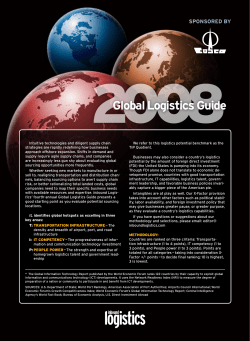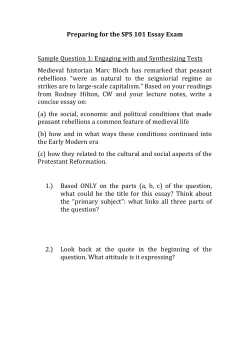
Your name: __________________________ Sample Final Exam Questions
Your name: __________________________ Economics 151 Development Economics Sample Final Exam Questions General Instructions. The exam has three parts. Part I contains 36 short-answer questions to be answered on these sheets, worth a total of 47 points. Part II has 3 questions to be answered briefly in lined booklets for a total of 13 points. Part III contains 3 essay questions, of which you are to select and answer 2 questions, also in lined booklets, for a total of 40 points. To allocate your time in proportion to the point values of these three parts, you should leave at least 75 minutes for Part III (at least 35 minutes per essay). I. Short answer questions. Answer the following questions directly on these sheets. Circle clearly only one answer per question. Questions preceded by an asterisk are worth 1 point each, the remaining questions are worth 1½ points each. NOTE: THESE SAMPLE QUESTIONS COVER THE LATE CHAPTERS ONLY, BUT OUT EXAM WILL INCLUDE QUESTIONS ON EARLIER CHAPTERS. 1. Between 1990 and 1997, total foreign direct investment (FDI) flows into developing countries a. declined significantly b. remained about the same c. increased by about 50% d. more than quadrupled 2. Which statement about FDI in 1997 is not correct a. China was the largest single FDI recipient among developing countries b. Brazil and Mexico were large recipients of FDI c. Russia was not among the top ten FDI recipients d. Sub-Saharan African countries accounted for less than 10% of total FDI to developing countries 3. The contribution of multinational enterprises to employment creation in developing countries a. is small in absolute numbers, but a major share of new job creation in the average host country b. is large, accounting for more than 20% of all employment in many countries c. is significant for the manufacturing sectors of some countries d. is almost uniformly negligible 4. Total commercial bank lending to developing countries fell significantly in the mid- and late 1980s. 1 T F 5. In the equation for the long-run equilibrium ratio of debt to GNP, D/Y = (v – s)/(gY – i) s stands for Savings/GNP and v stands for a. b. c. d. foreign savings as a share of total savings the velocity of money Investment/GNP none of the above 6. According to the equation for the level of sustainable debt as a share of exports, a country can maintain a positive level of debt indefinitely only if a. b. c. d. imports are less than exports imports are growing less rapidly than exports exports are growing less rapidly than imports the rate of growth of exports is higher than the interest rate 7. In the mid-1980s, some heavily indebted Latin American countries including Mexico exported more than they imported in order to pay off debt. T F 8. One difference between the highly indebted poor countries (HIPCs) of Africa and the Latin American countries hit hard by the debt crisis of the 1980s is that the HIPCs owed a higher proportion of their debt to private banks. T F 9. Among the countries hit hardest by the emerging market financial crisis of the late 1990s were Thailand, Malaysia, and a. b. c. d. South Korea Singapore Sri Lanka Pakistan 10. Which of the following best describes the text’s view of expectations and their role in creditor panics such as the one that lay behind the financial crises referred to in the previous question? 2 a. expectations play no role except where they are warranted by underlying facts b. the fear of borrower insolvency can generate problems in its own right, like a self-fulfilling prophecy c. the crises in question were almost entirely due to the groundless fears of creditors d. the text does not take up this issue 11. Major famines have become increasingly common in the developing world because world population growth has consistently outpaced the growth of the world’s food production capacity (based on technical knowledge and stocks of available inputs) during the past thirty years. T F 12. Slash-and-burn cultivation tends to be practiced where population is small relative to land. T F 13. Output per hectare of cultivated land tends to be higher in Taiwan and Japan than in the U.S. and Canada. T F 14. The textbook represents the isoquants of the mechanical package production function, where the inputs are labor and capital, as having a lower elasticity of substitution than those of the biological package production function, where the inputs are water and chemical fertilizer. T F 15. Evidence from many developing countries indicates that farmers do not increase production significantly in response to higher crop prices or lower input costs. T F 16. One of the few benefits of having an overvalued exchange rate is that it helps to protect farmers from cheap food imports, thereby spurring domestic agricultural production. T F 17. Economic theory shows that a country as a whole can always benefit from engaging in international trade if the ratio of world prices (e.g., of importables and 3 exportables) differs from the ratio of domestic prices that would hold in the absence of trade. T F 18. The real exchange rate (RER) falls (the domestic currency experiences a real appreciation) when the prices of nontradables rise more rapidly than do those of tradables. T F 19. As per capita income rises, manufacturing’s share of GDP tends to a. rise steadily b. rise first quickly, then slowly c. rise until reaching a plateau, where it is unaffected by further per capita income growth d. first rise, then level off, and finally decline slightly 20. When there are substantial economies of scale in an industry, manufacturing in a small, low-income country can be viable and efficient only if a. b. c. d. the industry serves export markets as well as the domestic market the government provides protection from competing imports the local industry is a monopoly all of the above 21. In their study of 18 industries in five developing countries, Yotopoulos and Nugent calculated that the leather industry had the highest total backward-linkage index. This means that a. leather production is more labor-intensive than the other industries studied b. the leather industry is the most efficient industry in these five countries c. an additional dollar of leather output generates a large demand for domestic inputs of all kinds, directly and indirectly d. leather production is more capital-intensive than the other industries studied 22. Suppose that there are two ways to make a batch of shirts. Method A uses 20 hours of labor and 20 hours of machine time. Method B uses 40 hours of labor and 10 hours of machine time. Suppose that the shadow price (or social cost) of a machine hour is $1. Then method A is the most efficient method to use provided that the shadow wage of labor is above/below Í (circle one, then fill in the blank) Î $ ______ 4 23. Zawana faces world prices for finished radios and radio components which are 100 shillings and 95 shillings, respectively. There is a 30 percent tariff on imported radios and no tariff on imported radio components. What is the effective rate of protection for the radio assembly industry in Zawana? a. b. c. d. 30 percent 60 percent 600 percent 5 percent 24. Suppose that Kenya imports film at a border price of $5 per roll, and that Kenyan shillings exchange at 70 shillings to the dollar. Suppose also that Kenya imposes a 50 percent tariff on imported film. What will be the cost of imported film in Kenya? a. b. c. d. 105 shillings 350 shillings 400 shillings 525 shillings 25. Which of the following is not a policy measure that is recommended for avoiding or minimizing the severity of “Dutch Disease”? a. b. c. d. tax exporters to discourage runaway export growth devalue the domestic currency control growth of government spending have government invest in human capital rather than increase salaries and transfer payments 26. In Figure 18-1, a country facing a price of Pw for imported cloth imposes a tariff of t0 per unit, raising the price of imported cloth to Pd. What happens to the country’s cloth imports? a. b. c. d. they rise from Q4 to Q3 they fall from Q3 to Q4 they rise from Q1 to Q4 they fall from (Q1 – Q2) to (Q3 – Q4) 27. Continuing to refer to Figure 18-1, the government’s revenue from the tariff equals area(s) a. b. c. d. a+b+c a+b+c+d b+c+d c 5 28. Which method of protection from imports leads to the smallest dead-weight loss (circle one): tariffs quotas subsidizing domestic industry without taxing the consumer 29. Studies show that low and middle income countries with high rates of growth of real per capita GDP between 1970 and 1996 also tended to have high rates of growth of exports of manufactured goods. True False 30. Countries such as Malaysia, South Korea and Thailand, which have succeeded in raising their exports of manufactured goods, have done so by following laissez faire policies including uncontrolled exchange rates and strict avoidance of import restrictions and export subsidies. True False Part II. Questions requiring brief written answers. Total point value: 13 points. 1. (3 points) How does the choice of a fixed (pegged) exchange rate versus a floating exchange rate impact upon a government’s ability to control inflation through monetary policy? 2. (5 points) Use a figure and words to explain the following: What is meant by saying that a country’s exchange rate is overvalued? Also briefly state: (a) Why should it be surprising to find that a country trying to protect its domestic industries from import competition has an overvalued exchange rate? (b) Why did countries following import substitute industrialization policies nonetheless often have overvalued exchange rates? III. Essay questions. Select two questions. (20 points each) Note: THIS SECTION CONTAINED THREE CHOICES OF ESSAY. ONLY ONE IS SHOWN HERE, AS AN ILLUSTRATION. 1. Write an essay about the roles of markets and governments in economic development, in which you discuss the following: a. Why do economists conclude that market forces provide good guides to the efficient allocation of resources over a wide range of economic activities, including the choice of production methods and input proportions? 6 b. Discuss some examples of ways in which government interference with market forces can lead to less efficient use of resources and to lower rates of economic growth. c. Is it true that the best approach for a government hoping to see its country develop economically is to do nothing, leaving everything to the market? If so, why? If not, what are some examples of actions that government can take that have been shown to foster economic development? Answers 1. d 2. c 3. c 4. T 5. c 6. d 7. T 8. F 13. T 14. F 15. F 16. F 17. T 18. T 19. d 20. a 9. a 10. b 11. F 12. T 21. c 22. above $0.50 23. (Pwt0 – Cwti)/(Pw – Cw) = ((100*.3) – (95*0))/(100 – 95) = (30 – 0)/5 = 6; Answer c 24. d 25. a 26. d 27. d 28. subsidizing . . . 29. T 30. F Part II 1. If the government maintains a fixed exchange rate, it can’t avoid importing any inflation that may be occurring in the world economy. 2. [Can draw a figure showing the demand and supply curves for foreign exchange, with the vertical axis measuring the price of foreign exchange in domestic currency. A horizontal line at the intersection of the curves can mark off the Yintercept, labeled P*.] The exchange rate is overvalued when the price is below P*, the market-clearing level. It then takes less local currency (say, pesos) to buy foreign currency (say, dollars) than would be the case if the price were dictated by market forces. (a) It’s surprising that a country trying to protect domestic industry would have an overvalued exchange rate, since such an exchange rate makes imports cheaper and thus more competitive with locally produced manufactures. (b) Overvalued exchange rates typically resulted from the combination of (i) higher domestic than world inflation rates, with (ii) fixed exchange rates and resistance to frequent devaluations. A major cause of this resistance was the influence of privileged urban consumers of imported goods, and opposition from manufacturers dependent on cheap imported inputs. 7
© Copyright 2025





















